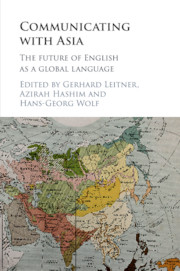Book contents
- Communicating with Asia
- Communicating with Asia
- Copyright page
- Contents
- Figures
- Tables
- Contributors
- Book part
- Communicating with Asia: introduction
- Part I English in selected regional and national habitats with a glance at the role of outward-bound communication needs
- 1 The development of English in Pakistan
- 2 English for Japan: in the cultural context of the East Asian Expanding Circle
- 3 Convergence and divergence of English in Malaysia and Singapore
- 4 Indian English prosody
- 5 Charting the endonormative stabilization of Singapore English
- 6 Arabic in contact with English and Malay in Malaysia
- 7 Preposition stranding and pied-piping in Philippine English: a corpus-based study
- 8 The Americanization of the phonology of Asian Englishes: evidence from Singapore
- 9 Postcolonial and learner Englishes in Southeast Asia: implications for international communication
- Part II Major other languages in Asia, their international status and impact on education
- Part III Wider perspectives
- Bibliography
- Index
5 - Charting the endonormative stabilization of Singapore English
from Part I - English in selected regional and national habitats with a glance at the role of outward-bound communication needs
Published online by Cambridge University Press: 05 January 2016
- Communicating with Asia
- Communicating with Asia
- Copyright page
- Contents
- Figures
- Tables
- Contributors
- Book part
- Communicating with Asia: introduction
- Part I English in selected regional and national habitats with a glance at the role of outward-bound communication needs
- 1 The development of English in Pakistan
- 2 English for Japan: in the cultural context of the East Asian Expanding Circle
- 3 Convergence and divergence of English in Malaysia and Singapore
- 4 Indian English prosody
- 5 Charting the endonormative stabilization of Singapore English
- 6 Arabic in contact with English and Malay in Malaysia
- 7 Preposition stranding and pied-piping in Philippine English: a corpus-based study
- 8 The Americanization of the phonology of Asian Englishes: evidence from Singapore
- 9 Postcolonial and learner Englishes in Southeast Asia: implications for international communication
- Part II Major other languages in Asia, their international status and impact on education
- Part III Wider perspectives
- Bibliography
- Index
Summary
The use of nativized multi-word verbal combinations (MVCs) such as discuss about, emphasize on and raise up is a characteristic of Singapore English (SgE) that has attracted much criticism from proponents of the standard language ideology in Singapore. In spite of this, these features have continued to prevail in SgE. Using a corpus-based approach, the present study demonstrates that nativized MVCs are relatively widespread, occurring in all six registers represented in the Singapore component of the International Corpus of English (ICE-SIN), and even in the most formal register of printed texts. Although not as common as their standard single-word variants (e.g., discuss, emphasize and raise) and dispreferred in careful language use, data from ICE-SIN show that these features occur in stable syntactic environments, and are assigned specific grammatical functions and structural characteristics that clearly define them. The fact that they can be found even in the most formal of text categories, such as parliamentary debates, legal cross-examinations, legal presentations, broadcast news, examination scripts and academic writing, suggests a need for the reevaluation of links between adherence to native-speaker norms, and user and uses variables (e.g., education level and social class of the speaker, and formality of the domain). Further, it suggests that these features have been institutionalized in SgE, or in Winford’s (2003) terminology, ‘conventionalized as part of the communal grammar’ of the language (p. 236). This chapter argues that they are structural and distributional manifestations of the stabilization of nativized MVCs in SgE.
- Type
- Chapter
- Information
- Communicating with AsiaThe Future of English as a Global Language, pp. 69 - 84Publisher: Cambridge University PressPrint publication year: 2016
- 1
- Cited by

